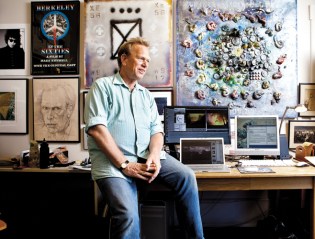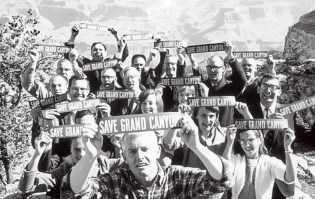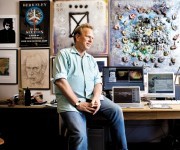
Mark Kitchell. (Photo by Gabriela Hasbun.)
This OnEarth story was written by Bruce Barcott.
In a creaky wood-floor office overlooking San Francisco Bay, the documentary filmmaker Mark Kitchell removes his glasses, runs his hand through his hair, and glares at a computer screen filled with thumbnail images of film clips. Kitchell, 59, is in the throes of a dilemma. He’s spent the past 10 years making A Fierce Green Fire, an epic documentary about the 50-year evolution of the modern environmental movement. He has two hours and 12 minutes in the can. And it’s good. “The material is vast, and it’s an incredibly dynamic film,” says Cara Mertes, head of the Sundance Institute Documentary Film Program, who has seen a rough cut. “It’s shaping up to be the documentary of record on the environmental movement. I think it’ll be hugely successful.” So Kitchell has buzz. What he doesn’t have is an ending. On this beautiful spring day, with a breeze blowing in from the bay, Kitchell is forced to confront his film’s ultimate question: What does the environmental movement mean?
He looks over columns of index cards tacked to the wall. Each represents an interview, a quote, a moment, culled from hundreds of hours of film.
“Let’s try that Paul Hawken clip one more time,” he tells his film editor. “It’s 8:12 into the interview.”
As the editor cues it up, Kitchell turns to me and recalls a recent moment at Hot Docs, an annual documentary film festival in Toronto. During a pitch session where filmmakers present works in progress to prospective buyers and distributors, Kitchell spoke and screened a three-minute trailer. “A guy from the BBC stood up and said, ‘So, what is the moral of the story? The images in the film are uplifting, but your words are pessimistic. Which is it?'”
Kitchell smiles wanly. “That’s the rub, right? Which is it?”
Hawken appears on the computer screen. The author of Natural Capitalism talks about environmentalism as a leaderless movement. “Nobody invented it,” he says. “Nobody created it. Nobody’s in charge.”
Kitchell halts the clip. “Do we cut it here or let him play out the metaphor?” he asks. Silence fills the room. “We’ve got to have the lightest touch. Short and sweet. It is the end of the film!”
Kitchell likes the Hawken clip but he’s not yet sold. He paces. He consults the index cards again. He turns to me. “I think the world is still waiting for the environmental movement’s defining film, a movie that brings the pieces together into a big picture and delivers the meaning of environmentalism,” he says. “It’s got to be done in an intelligent, compelling way. No pounding people over the head. The brass ring is there for us to grab, and I think we’re going to grab it.”
He takes a deep breath and returns his attention to the screen. “All right,” he tells the editor. “Let’s bring up that Carl Pope bit … ”
***

In the 1960s, David Brower fought plans to build dams in the Grand Canyon. (Photo by Arthur Schatz/Time & Life Pictures/Getty Images.)
I first came across Kitchell’s film in April, when he sent me a fundraising email. He was trying to gin up a few bucks through Kickstarter, a website where entrepreneurs of all sorts can appeal to the masses to crowd-fund their projects. The director’s name jumped out at me. Kitchell’s previous documentary, Berkeley in the Sixties, chronicled the stirrings of student activism at the University of California, from early sit-ins to the battle over People’s Park. Released in 1990, the film became a defining document of the ’60s. Berkeley was nominated for an Oscar and won the National Society of Film Critics award for best documentary.
I’d always wondered what Kitchell had done after Berkeley. The idea of creating a film history of the environmental movement struck me as audacious and, frankly, financially insane. Intrigued, I called him up.
“We’re just about done,” he told me. “I’m figuring out how to open and close the film. You’re welcome to come watch us work.”
I hopped a plane to San Francisco and found him in his office, which is in a former military hospital in the Presidio that’s been converted into a warren for local nonprofit groups. Kitchell is a laid-back Californian, melancholy and mellow. He keeps a lot of art on the walls. One arresting piece looks like a whirlpool of trash. “It’s based on the Pacific garbage gyre,” he told me. “Oceans. One of the many strands I had to leave out of the film.”
Before we talked further, he sat me down with a rough cut and a pair of headphones. “I’ll be anxious to see what you think,” he said. “See you in two hours.”
A Fierce Green Fire unfolds in five acts, each following a strand of the modern environmental movement. There’s David Brower and the Sierra Club fighting to keep dams out of the Grand Canyon in the ’60s. The Love Canal saga of the ’70s explores the ravages of industrial pollution. Greenpeace’s “Save the Whales” campaign marks the beginnings of direct-action activism. Chico Mendes and the Amazon rainforest story exemplify the globalization of the movement. And, finally, there’s climate change, embodied by catastrophes both physical (Hurricane Katrina) and political (America’s 20 years of inaction). Five acts to capture the entire half-century of modern environmentalism. It’s an epic work of history. At the film’s heart are the three middle acts — Love Canal, Greenpeace, and Chico Mendes — stories of unlikely heroes who risked their lives (and in Mendes’ case, lost it) to stop profit-driven destruction. We’re so far from Love Canal today that it’s nothing short of shocking to relive the story — the water poisoning and birth defects caused by routine toxic dumping, the uncaring government officials, the radical action taken by housewives. As Kitchell later remarked, “These women took EPA officials as hostages! Can you imagine?”
The film left me emotionally drained and profoundly hopeful. I’ve read a lot of environmental histories — Ted Steinberg’s Down to Earth and Philip Shabecoff’s A Fierce Green Fire are among the best — but none has the power of film. None leaves you with images of early Greenpeace leaders Paul Watson, Bob Hunter, and Rex Weyler putting their bodies between a sperm whale and a Soviet whaling ship firing exploding harpoons.
“I came home from the Oscars in 1991 with a year-and-a-half-old daughter and my wife about to give birth to number two,” Kitchell told me over a lunch of vegetables from the common-area fridge. The success of Berkeley was gratifying but not world-changing. To make rent, he directed TV shows and short documentaries. While scouting for his next big project he kept returning to the idea that had captivated him in Berkeley: people forcing change. In 2001, he said, he found his subject — the history of the environmental movement.
Kitchell is obsessed with movement, whether it’s kinetic energy on screen, political movements in the world, action forcing change. Berkeley in the Sixties opens with a rollicking scene of cops hauling student protesters down a flight of stairs — bumpety-bumpety-bump — over a soundtrack of Little Richard’s “Keep a-Knockin’.” It was Kitchell’s way of telling viewers this would be no sleepy documentary.
“That’s what attracted me to environmentalism — the movement,” Kitchell told me. “I read every environmental history I could get my hands on. They all started with 150 pages of prologue: Thoreau, George Perkins Marsh, John Muir.” He mimicked a man falling asleep. “I decided I wasn’t gonna do ’em. I wanted a film about the environmental movement, the story of people fighting for change. And that really kicked off in the ’60s, with David Brower fighting dams in the Grand Canyon.”
Greenpeace pioneered a new style of activism with its direct confrontations with whaling ships. (Photo by Rex Wyler.)
Making a low-budget historical documentary means finding archival footage on the cheap. Kitchell spent years poring over previous documentaries, TV station archives, private home movies, searching any closet that might contain crumbling celluloid or videotape. There were some unpleasant surprises. In the decade since he shot Berkeley in the Sixties, the corporations that own local TV stations realized that their old images could be milked for money. “In the mid-’80s, I bought rights to the entire news archives of three San Francisco stations for a dollar each,” Kitchell told me. “By 2001, when I went looking for Love Canal footage, TV stations in Buffalo were demanding $60 per second.”
The project eventually grew into a six-part series. “There were so many great stories,” Kitchell said. “The snail darter and Tellico Dam. The stopping of New York City’s Westway freeway. Even NRDC’s story, evolving from an environmental law firm to this concatenation of expertise and global organization.”
Then in 2003 he traveled to Cambridge, Mass., to see the biologist Edward O. Wilson. Wilson, who has written both dense scientific treatises and more breezy best sellers, gave Kitchell some advice. He could make a comprehensive reference work seen by few or a movie seen by many. But he couldn’t do both.
“The audience does not want six hours, Mark,” Wilson told him. “They will stop watching. They will walk out on you.”
“He was right,” Kitchell told me. “There are hundreds of great documentaries out there that get seen by no one.” When he got home, Kitchell killed everything except the five most gripping segments. Gone was Westway. Gone was NRDC — “I interviewed [NRDC founder] John Adams for four hours,” he recalled, “and had to lose all but a few quotes.”
Modern documentary films can be neatly parted into two epochs: before Michael Moore and after. The Before Moore period was marked by gritty cinema vérité classics such as Frederick Wiseman’s Titicut Follies, Albert and David Maysles’ Grey Gardens, and Barbara Kopple’s Harlan County, U.S.A. — brilliant, highly regarded films seen by small audiences in art-house cinemas.
Then came 2002 and Bowling for Columbine. “Michael Moore blew the top off what a documentary could do at the box office,” says Ward Serrill, whose movie about a high school girls’ basketball team, The Heart of the Game, was a minor hit in 2006. “Bowling for Columbine made more than $20 million, and distributors all over the country said, ‘Whoa! Documentaries can make money!'”
Other factors came into play. Netflix made obscure documentaries available to the masses thanks to Ted Sarandos, the company’s chief content officer and a big documentary fan. And reality TV introduced new viewers to nonfiction. “Reality television helped change the audience’s attitude,” says Ruth Hayler, a Seattle-based film buyer for the Landmark Theatres chain. “They realized nonfiction didn’t have to be dry and boring.”
“I’m wary of message-oriented films,” says Andrew Herwitz, president of the Film Sales Company, a New York-based distributor that handled foreign rights for Fahrenheit 9/11, the top box-office documentary of all time (it grossed $119 million domestically), as well as the Oscar-winning Born Into Brothels. “There’s still a tendency for people to feel they’re medicinal.” But environmental films can make money. Davis Guggenheim’s An Inconvenient Truth brought in $24 million, the sixth-biggest box-office haul among documentaries. Eight of the top 10, in fact, are either politically charged (such as Moore’s Fahrenheit 9/11, Sicko, and Bowling for Columbine) or related to the natural world (Earth, African Cats, and March of the Penguins, the No. 2 documentary of all time with a $77 million gross).
“I don’t know that environmental subject matter works for or against a film,” says Cara Mertes, whose documentary film program, which offers support to 50 documentaries every year, is an arm of the Sundance Institute. Two years ago A Fierce Green Fire was picked from among more than 2,000 applicants for Sundance backing. One advantage for Kitchell, she says, is the existence of “a long list of environmental stakeholder groups and their allies” that could provide a core audience.
Those groups may be interested in seeing the film. But that doesn’t mean they’re eager to fund it.
There are a handful of documentary filmmakers, like Moore, who can walk into a room and line up $1 million with nothing but their name and a good pitch. For filmmakers like Kitchell, though, fundraising is a constant struggle. In 2004, despite the new popularity of documentaries, A Fierce Green Fire ran out of money. So Kitchell had to teach filmmaking at the University of California at Santa Cruz and work as a location scout for film and television. By 2008, he’d scraped together enough cash to restart the film.
“I had enough to pay two editors,” he said. “The bad economy meant we could get a couple of great interns.” But he still needed to shoot the final act, about climate change. That’s when he found his angels. Patricia Matthews, a documentary producer, was a big fan of Berkeley in the Sixties. She asked her husband, Edwin, to watch a rough cut of A Fierce Green Fire. Edwin Matthews founded Friends of the Earth International and now runs the private Gould Family Foundation. He liked what he saw, and persuaded the foundation to give Kitchell $100,000 in grants to help finish the project.
With a five-act rough cut, Kitchell landed more funding from the Sundance Institute Documentary Fund. Then he went after bigger game.
In the past few years a pitching circuit has developed for documentary filmmakers. These confabs happen a few times a year in cities like New York, Los Angeles, Amsterdam, Toronto, and Berlin. Producers and distributors sit and listen as dozens of filmmakers pitch their works in progress. It’s speed dating for filmmakers.
In May 2011, Kitchell pitched A Fierce Green Fire to a roomful of international buyers at Toronto’s Hot Docs film festival. “It’s like being the prime minister during question time in Parliament,” Kitchell told me. “You show three minutes of the film, then talk another three, then nine minutes of questions. Fifteen minutes, time’s up!”
Nick Quested, executive director of Goldcrest Films, was intrigued. His London-based company has financed or distributed a slew of award-winning films, including Gandhi, Chariots of Fire, and Local Hero. Restrepo, the Academy Award-nominated documentary, was finished at Goldcrest’s postproduction studios.
Quested sidled up to Bruni Burres, a consultant for the Sundance documentary film program who had introduced Kitchell onstage. “I can put up the money to finish that film,” he told her.
Kitchell tracked down Quested the next day. “We bonded over our shared love of Marjoe,” a 1972 documentary about a child preacher on the revival circuit, Kitchell recalled.
What’s it going to take to finish A Fierce Green Fire, Quested asked, and Kitchell laid out his completion costs. Twenty thousand for graphics. Ten each for music and narration. Twenty for audio design and mixing. Thirty to dig up and remaster archival footage, and 50 for the rights to footage that didn’t qualify as “fair use.” (Copyright law allows filmmakers to use bits of copyrighted film without permission as long as they’re part of a social, political, cultural, or historical critique.) Thirty for staff, travel, and overhead. Another 30 for the online edit.
Bottom line: With $200,000, Kitchell could have A Fierce Green Fire ready in time for submission to the January 2012 Sundance Film Festival. He and Quested shook hands. They didn’t have a deal, but they had a deal to work out a deal.
***
I continued to follow Kitchell’s progress over the next few months. When I spoke with him in August, his lawyer was talking with the lawyers at Goldcrest. “They’re going over the fine details,” he told me. “My fate may get decided as I sit here.”
Goldcrest’s distribution strategy was turning into a point of dispute. “I’m insisting on right of approval on that,” Kitchell said with a sigh. “It’s the whole rolling-out of the film. It’s the biggest part of filmmaking that some people don’t pay attention to, to their detriment. I learned that on Berkeley in the Sixties. There are two ways to open a film. You can open on one weekend in 40 cities nationwide, and it flies or dies. That won’t work with this film. It’s better to go city to city, cross-promote with local environmental groups, get publicity from local papers and radio stations.”
Six weeks later Kitchell called with bad news. “Well, the Goldcrest deal fell through yesterday,” he said.
“What happened?”
“The main sticking point was my right of approval over distribution,” he told me. “But I think the bigger unspoken reason was money.” Kitchell had asked for half of the necessary $200,000 in cash, and half in in-kind postproduction services — in other words, the use of their equipment. “The deal just got too big for their comfort on the cash front.”
I asked where he went from here. He told me he already had interest from other quarters. A Fierce Green Fire was being considered by the Independent Television Service, which broadcasts documentaries on PBS. And a Bay Area film distributor had contacted him after seeing a rough cut of the film. “He’s got a studio capable of doing the final picture edit,” Kitchell said, “and we’re talking about ways to parcel out the other pieces among people in the business willing to do us favors.”
“So I’ve got Plan A, B, and C,” he said. Plan A required another angel to front $200,000 cash. Plan B could be done on $70,000 and a lot of in-kind contributions from friends and colleagues. Plan C would use $15,000 to take the film as far as Kitchell could on Final Cut Pro editing software and show that version at Sundance, which could lure a buyer. “I’m due to submit to Sundance in 10 days,” he told me. So … for now, it’s Plan C. “If they decide to take the film, the race is on to get it done in time for a January premiere.”
The good news, Kitchell said, was that he’d found the film’s closing. “That question from the producer at Hot Docs stayed with me all summer,” he told me. “What’s the moral of the fable? What’s the meaning of environmentalism?”
“How did you answer it?” I asked.
“I got it down to about 45 seconds of narration at the end,” he said, “but it didn’t have the gravitas and brilliance that I’d hoped for. So we cut it. But that’s okay. Because then I can turn it over to Paul Hawken, and he leaves us with the idea that everybody’s always declaring the environmental movement dead and gone. But it’s not, because it’s not even a movement, in the traditional sense.” He played the clip for me. Hawken describes environmentalism as humanity’s immune response to the industrial despoliation of the planet. It’s an intriguing idea: thousands upon thousands of grassroots groups, causes, and movements acting like so many white blood cells all over the globe.
Kitchell paused for a second.
“It’s always the toughest trick on these films,” he said. “How do you finish them?”
He hung up the phone and returned to the task of doing it.
A Fierce Green Fire will screen at Sundance on Jan. 23.



